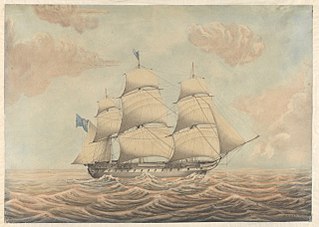
HMS Myrmidon was a 20-gun Hermes-class sixth-rate post ship built for the Royal Navy during the 1810s. She was commissioned in 1813 and was in the Mediterranean four years later. The ship was on the Africa Station in 1819 and was paid off three years later. Myrmidon was broken up in 1823.

HMS Ariadne was a 20-gun Hermes-class sixth-rate post ship built for the Royal Navy during the 1810s. The vessel was completed in 1816, modified in the early 1820s and only entered service in 1823. Ariadne was assigned to the Cape of Good Hope Station, followed by a stint in the Mediterranean Sea. The ship served on the North America and West Indies Station from 1829 to 1835. She was paid off in 1835, turned into a coal hulk the following year and sold for scrap in 1841.

HMS Arethusa was a 46-gun Leda-class fifth-rate frigate built for the Royal Navy during the 1810s. The ship was never commissioned and was converted into a lazarette in 1836. She was renamed HMS Bacchus in 1844 and was further converted into a coal hulk in 1851–52. The ship was sold for scrap in 1883.

HMS Melampus was a 46-gun modified Leda-class fifth-rate frigate built for the Royal Navy during the 1810s. Completed in 1820, she was not commissioned until 1845 for the South America Station and was converted into a store and receiving ship in 1855. The ship was briefly assigned as a coast guard ship before being paid off in 1858. Melampus was converted into a Roman Catholic chapel ship in 1866 and then became a store ship twenty years later. The ship was sold for scrap in 1906.
HMS Thisbe was a 46-gun modified Leda-class fifth-rate frigate built for the Royal Navy during the 1820s. The ship was never commissioned and spent her entire career in reserve or on third-line duties. She was converted into a depot ship in 1850 and then into a floating church in 1863. Thisbe was replaced by a shore-based establishment, All Souls Chapel, in 1891 and sold for scrap the following year.
HMS Druid was a 46-gun Seringapatam-class fifth-rate frigate built for the Royal Navy during the 1820s, the name ship of her sub-class.

HMS Nemesis was a 46-gun Seringapatam-class fifth-rate frigate built for the Royal Navy during the 1820s, one of four ships of the Druid sub-class.

HMS Stag was a 44-gun Seringapatam-class fifth-rate frigate built for the Royal Navy during the 1820s, one of three ships of the Andromeda sub-class.
HMS Seahorse was a 44-gun Seringapatam-class fifth-rate frigate built for the Royal Navy during the 1820s, one of three ships of the Andromeda sub-class. After completion in 1830, she was ordered to be converted into a steam-powered ship in 1845, but this did not happen for another decade.
HMS Forth was a 44-gun Seringapatam-class fifth-rate frigate built for the Royal Navy during the 1820s, one of three ships of the Andromeda sub-class. After completion in 1833, she was ordered to be converted into a steam-powered ship in 1845, but this did not happen for another decade.
HMS Racer was a 6-gun Nightingale-class cutter built for the Royal Navy in 1818. She was broken up in 1830.
HMS Reynard was a 10-gun Cherokee-class brig-sloop built for the Royal Navy during the 1820s. She was sold in 1838.
HMS Skylark was a 10-gun Cherokee-class brig-sloop built for the Royal Navy during the 1820s. She was wrecked in 1845.
HMS Spey was a 10-gun Cherokee-class brig-sloop built for the Royal Navy during the 1820s. She was wrecked in 1840.
HMS Pigeon was a 10-gun Cherokee-class brig-sloop built for the Royal Navy during the 1820s. She was sold in 1847.
HMS Wizard was a 10-gun Cherokee-class brig-sloop built for the Royal Navy during the 1820s. She was wrecked in 1859.

HMS Meteor was a Hecla-class bomb vessel built for the Royal Navy during the 1820s. In July 1832 she was renamed Beacon and reclassified as a survey ship, and was sold in 1846.
HMS Grecian was a sixteen-gun Acorn-class brig-sloop built for the Royal Navy during the 1830s.
HMS Persian was a sixteen-gun Acorn-class brig-sloop built for the Royal Navy during the 1830s.
The Stromboli class was a group of two vessels designed by Sir William Symonds the Surveyor of the Navy. The design was approved on 29 August 1838. The vessels were of the Medea design but were altered to the new draught derived from the Gorgon. The ships were initially classified as Steam Vessels Second Class (SV2) and were later classified as First Class sloops. The ships were built in two Royal Dockyards. Both ships were at the bombardment of Acre in 1840. Both were in the Black and Azov seas during the Russian War. They served on various stations of the Empire. Vesuvius was sold in 1865 and Stromboli in 1866. Both were broken by White at East Cowes on the Isle of Wight.









